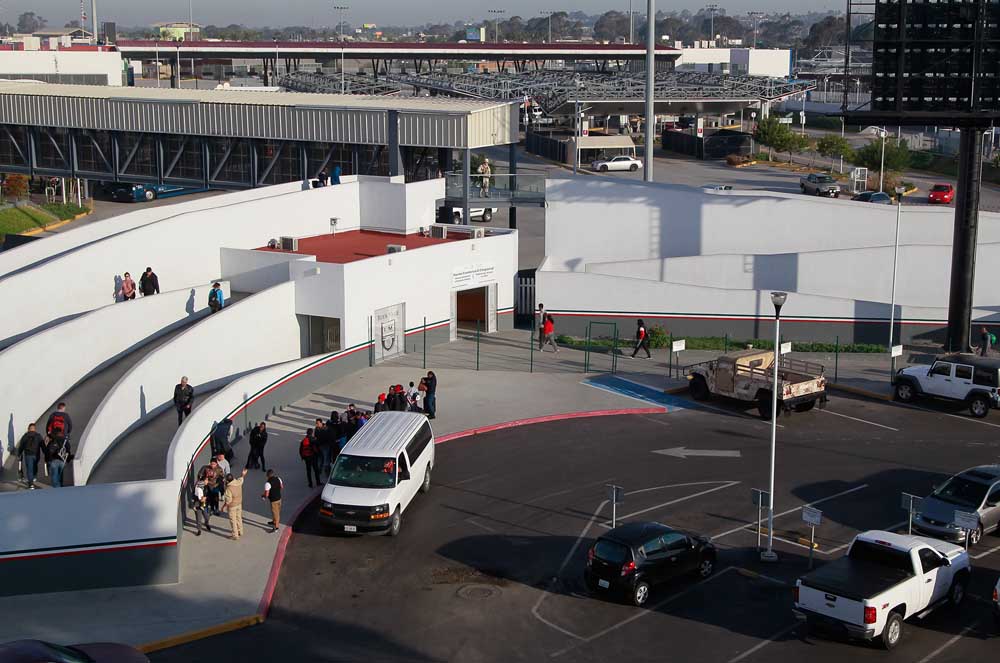Remain in Mexico has a 0.1% asylum grant rate
Published 11:45 pm Monday, December 16, 2019

- A van with migrants seeking asylum in the U.S. in April at El Chaparral border crossing in Tijuana, Mexico.
SAN DIEGO — Bryan thought it would take him about a month to get from Honduras to the United States last year.
He was 19 at the time, living by himself, and had already been kidnapped by local gangs once. Men stripped him naked, checked his bodies for tattoos that are seen as a sign of gang affiliation there and beat him after they found none. When the men were done, they gave Bryan three seconds to run away.
So, in October 2018, when Bryan heard that a migrant caravan was heading to the U.S.-Mexico border, he decided to tag along.
It did take Bryan a month to get to the border. What he didn’t realize was that that was only the beginning of a yearlong struggle to request asylum.
That’s because Bryan arrived at the border at a time when the Trump administration had begun making drastic changes to U.S. asylum policy.
Over the last year, in the name of national security, those changes have made it increasingly difficult for migrants to win asylum cases in the U.S. The latest change has effectively made the majority of non-Mexican migrants ineligible for asylum, according to lawyers and activists.
One policy in particular, called Migrant Protection Protocols or Remain in Mexico, has made it nearly impossible for migrants to receive asylum.
Data show that, as of September, of the more than 47,000 people in the program, fewer than 10,000 had completed their cases. Of that group, 5,085 cases were denied while 4,471 cases were dismissed without a decision being made — mostly on procedural grounds.
Only 11 cases — or 0.1% of all completed cases — resulted in asylum being granted, according to the Transactional Records Access Clearinghouse at Syracuse University.
Bryan was not one of those 11 cases. He is currently waiting to be deported back to Honduras. He’s still afraid of the gangs. He asked the San Diego Union-Tribune not to use his last name because he was afraid they would identify him.
That 0.1% grant rate is significantly lower than the 20% who were granted asylum outside of the Remain in Mexico process, according to data from the Executive Office for Immigration Review.
That same data show a 48% denial rate and a 30% “other” rate in 2018. The “other” category means that asylum cases either ended without a decision being made or were withdrawn for some reason.
Before being enrolled in the Remain in Mexico program, Bryan was faced with one of the first major changes the Trump administration made to asylum policy: expanding the metering program.
Metering forces migrants at the border to wait months in Mexico before getting a chance to turn themselves in to Customs and Border Protection agents.
Officials at the Department of Homeland Security defend the practice, saying there is a limited amount of space in holding facilities where they process migrants who enter the country without proper documentation. To prevent overcrowding, they need to manage the number of people who enter each day.
There are more than 10,000 migrants currently in Tijuana waiting to enter the United States and legally asking for asylum. Many have been there for months, and on some days, none of them are allowed to enter the country. Instead of waiting, several people either cross illegally into the U.S. or turn around and go back home.
Advocates who have sued the federal government over the metering program argue that it violates international laws by preventing migrants from exercising their right to request asylum — particularly Mexican asylum seekers who must wait in the same country they’re fleeing.
In Bryan’s case, metering meant that even though he arrived to the border in November 2018, he didn’t get a chance to actually enter the country until January.
The three-month wait made Bryan subject to the Trump administration’s second drastic change to U.S. asylum policy: Remain in Mexico.
Officially known as Migrant Protection Protocols, the policy requires asylum seekers with immigration court cases in the U.S. to wait in Mexico until their cases are adjudicated.
The program was announced by the Department of Homeland Security in January as a response to changing demographics at the border. The migrant caravan brought a lot of women and children, which presented a problem to Customs and Border Protection because they were used to interacting with adult men.
The logic behind Remain in Mexico is that forcing people to spend months in Mexico waiting for their cases will deter them from filing false asylum claims. That, in theory, should free up the courts to process legitimate claims. But advocates on the ground have long argued that the program, along with the administration’s other changes to asylum policy, also deters migrants from submitting legitimate claims.
“There’s metering, there’s Remain in Mexico, there’s the new asylum ban. Basically, the process is blocking people from getting asylum,” said Kennji Kizuka, senior researcher and policy analyst for Human Rights First.
The “asylum ban” Kizuka refers to is the third asylum policy change. That one, enacted in July, makes non-Mexican asylum seekers at the southern border ineligible for asylum unless they’ve already requested asylum in another country.
Kizuka has spent most of this year researching the living conditions of migrants returned to Mexico. He has helped author several reports, each one documenting an increasing number of migrants being robbed, beaten, kidnapped and raped south of the border. The latest report, published Thursday, identified 636 reported cases of kidnapping, torture and other violent attacks on asylum seekers who were part of the Remain in Mexico program. That figure includes 138 cases of kidnapping or attempted kidnapping of children.
Kizuka says legitimate asylum seekers who have fled their homes are choosing to go back because they are afraid they’ll die in Mexico.





